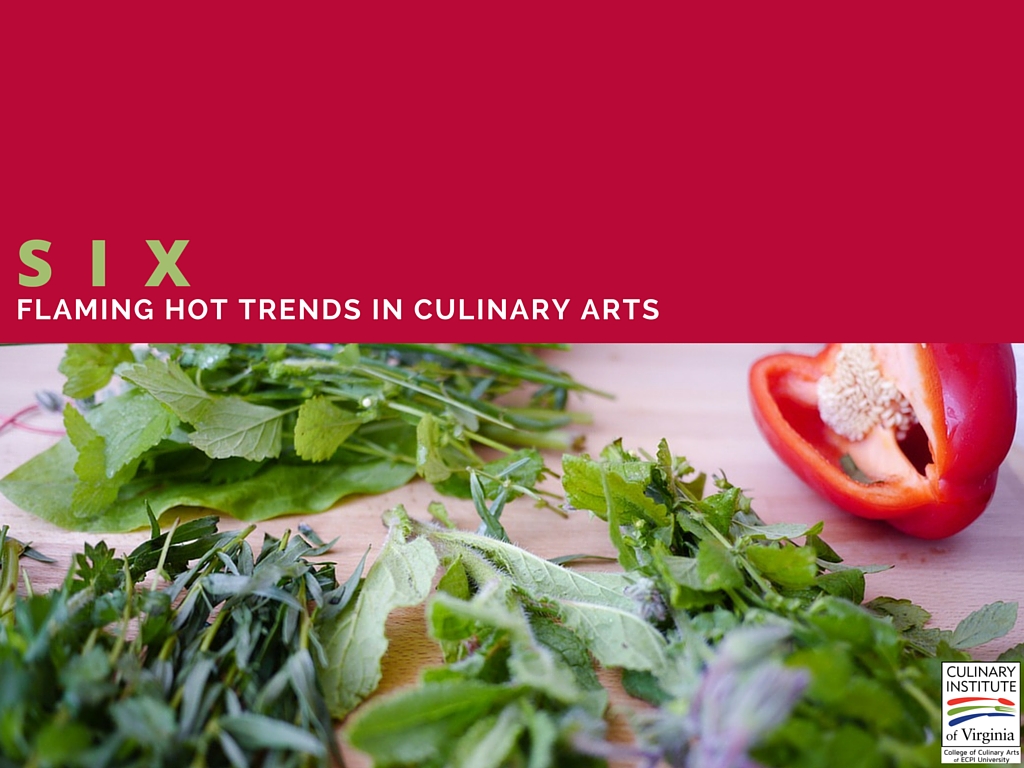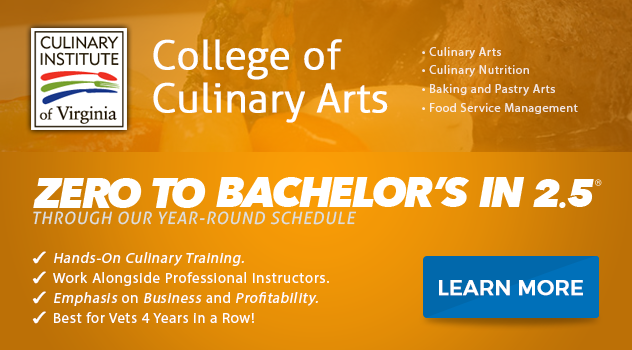
In chef training, you learn that you never stop learning! New ideas and methodologies that will better serve your skills and your clients are always being discovered; your job is to differentiate between the fads and the trends, then decide how you will (or will not) use them. The difference between a “fad” and a “trend” is that a fad pops up and dies out in the wink of an eye. Trends impact, long-term, how we think, and what we practice in any discipline, including culinary arts.
Hudson Riehle of the NRA research and knowledge group says chefs and restaurateurs should follow trends carefully, but always add their own “culinary creativity” to drive those trends. No one else has a better understanding of food trends than culinary professionals, he continues, and the National Restaurant Association (NRA) surveyed over 1,000 chefs to discover trends for 2016. That forecast, “What’s Hot,” lists over twenty trending foods and methodologies of food preparation for the public.
Culinary arts are an adventure every year, but these 6 trends cited by some of the finest chefs in the U.S. have the ingredients for a better way of living:
1. Going Local
Locally-grown fruits and vegetables and locally-sourced meats and seafood are what U.S. diners prefer, and restaurants will continue to feature local foods and downplay trucked- or flown-in meats and produce. In fact, “hyper-local” is another hot trend – you may need a gardener to manage your restaurant or company farm!
2. In-house Production
In-house production is a trend that is considered a healthy advantage because of fewer manufacturing and processing potentials for contamination; plus, it’s fun and interesting! Milling your own flour onsite can lead to gourmet pizza crusts or specialty breads. Other restaurants are creating their own brand of artisan pickles, making their own ice cream, and grinding their own meats or creating unique blends of sausages. This is the kind of trend that leads to signature dining experiences!
3. Healthy Children’s Menus
Introduce healthier foods to the chicken-fingers-and-fries bunch by substituting green-veggie-based sides that are appealing to younger, inexperienced palates. You can also disguise vegetables and high-fiber bulgur in ground meat recipes, whole wheat, or spinach pastas (using names like “Goofy Green Mac & Cheese”), use whole wheat for pizza crusts, and offer fruit desserts lower in sugar. Your parental clientele will be grateful!
4. Street Food and Food Trucks
One city food truck prepares nothing but grilled cheese sandwiches. But the sandwiches include thick, sourdough or ancient grains breads and several good cheeses with thin fig, mango, and other wonderful spreads and chutneys. The chef travels to different downtown areas every day of the week, and you can see the lines of customers stretching almost one city block! Add pepper potato chips and a flavored water, and this lunch wagon fare is in-demand for working professionals!
5. Ethnic Cuisine
African and Middle Eastern fare have been coming into their own for several years, but 2016 may see a surge in ethnic breakfast menus, and we’re not talking breakfast burritos (which are Mexican-inspired, but not Mexican). Some of the more popular international choices for U.S. diners may include rice congee (Asia), cheese blintzes (Russia), chilaquiles with cotija cheese (Mexico), or foul and labneh (Middle East). Following years of British influence, Capetown’s (Africa) Mugg and Bean restaurant serves a hearty egg, sausages, bacon, tomato, potato and chutney breakfast.
6. Limiting Food Waste and Maximizing Sustainability
From a marketing standpoint, restaurants advertising that they take measures to promote ecological sustainability are preferred by diners. Plus, it’s the right thing to do. Here in the U.S. it will become necessary for restaurants to control portions and educate the public about the emotional impact of wasted food. Exploring food recovery solutions is important; for example, The Good Samaritan (Food Donation) Act releases food organizations and restaurants from liability when donating food waste (that meets standards for quality but is not marketable because of its appearance, age, or surplus) to a nonprofit that assists those in need.
Now Trending: The Business of Culinary Art
Chef training can lead to many more career opportunities than you imagine! Businesses recognize a formal education for what it is: the ability to be disciplined and to commit to your career goals. Chef training that leads to an Associate of Applied Science in Culinary Arts could lead to the job opportunities you’ve only dreamed of. No matter what your age, it’s never too late to make a decisive change for a better life. Chef training at the Culinary Institute of Virginia is available when you want it, with a year-round schedule. It could be the Best Decision You Ever Make!
Ecpi #Culinary school sooooo excited. .. pic.twitter.com/5ffahbRJIM
— Lakisha Lilly (@lakisha_lilly) August 4, 2015
DISCLAIMER – ECPI University makes no claim, warranty, or guarantee as to actual employability or earning potential to current, past or future students or graduates of any educational program we offer. The ECPI University website is published for informational purposes only. Every effort is made to ensure the accuracy of information contained on the ECPI.edu domain; however, no warranty of accuracy is made. No contractual rights, either expressed or implied, are created by its content.
For more information about ECPI University or any of our programs click here: http://www.ecpi.edu/ or http://ow.ly/Ca1ya.


